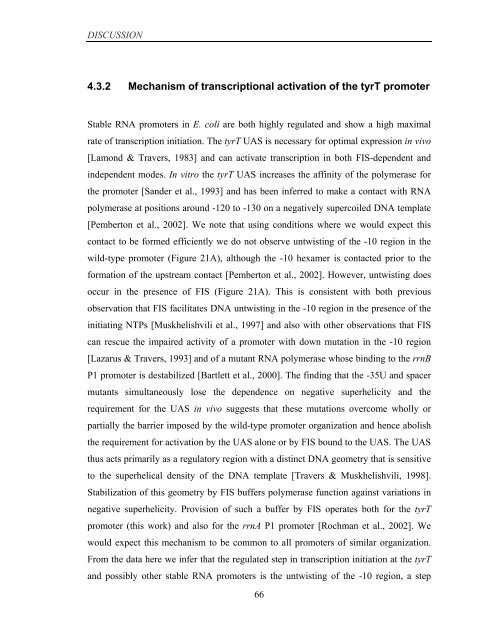Coordinated regulation of gene expression by E ... - Jacobs University
Coordinated regulation of gene expression by E ... - Jacobs University
Coordinated regulation of gene expression by E ... - Jacobs University
Create successful ePaper yourself
Turn your PDF publications into a flip-book with our unique Google optimized e-Paper software.
DISCUSSION<br />
4.3.2 Mechanism <strong>of</strong> transcriptional activation <strong>of</strong> the tyrT promoter<br />
Stable RNA promoters in E. coli are both highly regulated and show a high maximal<br />
rate <strong>of</strong> transcription initiation. The tyrT UAS is necessary for optimal <strong>expression</strong> in vivo<br />
[Lamond & Travers, 1983] and can activate transcription in both FIS-dependent and<br />
independent modes. In vitro the tyrT UAS increases the affinity <strong>of</strong> the polymerase for<br />
the promoter [Sander et al., 1993] and has been inferred to make a contact with RNA<br />
polymerase at positions around -120 to -130 on a negatively supercoiled DNA template<br />
[Pemberton et al., 2002]. We note that using conditions where we would expect this<br />
contact to be formed efficiently we do not observe untwisting <strong>of</strong> the -10 region in the<br />
wild-type promoter (Figure 21A), although the -10 hexamer is contacted prior to the<br />
formation <strong>of</strong> the upstream contact [Pemberton et al., 2002]. However, untwisting does<br />
occur in the presence <strong>of</strong> FIS (Figure 21A). This is consistent with both previous<br />
observation that FIS facilitates DNA untwisting in the -10 region in the presence <strong>of</strong> the<br />
initiating NTPs [Muskhelishvili et al., 1997] and also with other observations that FIS<br />
can rescue the impaired activity <strong>of</strong> a promoter with down mutation in the -10 region<br />
[Lazarus & Travers, 1993] and <strong>of</strong> a mutant RNA polymerase whose binding to the rrnB<br />
P1 promoter is destabilized [Bartlett et al., 2000]. The finding that the -35U and spacer<br />
mutants simultaneously lose the dependence on negative superhelicity and the<br />
requirement for the UAS in vivo suggests that these mutations overcome wholly or<br />
partially the barrier imposed <strong>by</strong> the wild-type promoter organization and hence abolish<br />
the requirement for activation <strong>by</strong> the UAS alone or <strong>by</strong> FIS bound to the UAS. The UAS<br />
thus acts primarily as a regulatory region with a distinct DNA geometry that is sensitive<br />
to the superhelical density <strong>of</strong> the DNA template [Travers & Muskhelishvili, 1998].<br />
Stabilization <strong>of</strong> this geometry <strong>by</strong> FIS buffers polymerase function against variations in<br />
negative superhelicity. Provision <strong>of</strong> such a buffer <strong>by</strong> FIS operates both for the tyrT<br />
promoter (this work) and also for the rrnA P1 promoter [Rochman et al., 2002]. We<br />
would expect this mechanism to be common to all promoters <strong>of</strong> similar organization.<br />
From the data here we infer that the regulated step in transcription initiation at the tyrT<br />
and possibly other stable RNA promoters is the untwisting <strong>of</strong> the -10 region, a step<br />
66
















